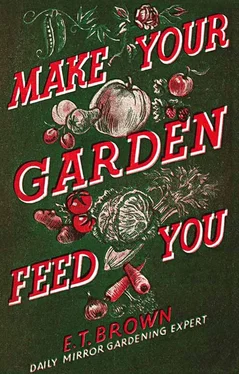The exact positioning of the shed fitments is left to the individual, but one or two points may be briefly discussed.
1. Under each window there should be a table about 2 ft. in width, with a series of drawers below.
2. There should be plenty of hooks and nails on the walls, so that gardening tools and other articles may be hung up, with shelves above for storing some of the smaller utensils.
3. If any poultry food is stored in this shed, suitable bins can be made out of tea-chests, barrels or crates, but the most satisfactory container is the galvanised iron dustbin. If the shed floor is of natural earth the food receptacles should be stood on a slatted platform to preserve them from damp.
IN many districts the local authorities are taking over large tracts of land and converting them into allotments. As a general rule, the area is simply measured off into plots, and those who take them over have to do all the necessary “spade-work”; and spade-work it is, in very truth. Before dealing with the usual routine work connected with vegetable-growing it may be advisable to say something regarding the best way of turning a piece of rough land into an allotment.
Quite apart from the nature and texture of the land itself its condition must be considered. The new allotment site may be either a piece of old grassland or waste ground. These require rather different treatment to bring them into a productive state.
If the area of ground allotted to you consists of turfed land, the first job is to remove the sods. This means a considerable amount of work, but one is repaid handsomely, since the turves as they are removed can be heaped up in a corner of the plot and converted into an excellent manure substitute in about six months’ time. The turves and the soil below are almost certain, however, to be infested with wire-worms and similar pests, so thorough fumigation of the former as they are stacked up and of the latter when it is being dug is essential. 1
HOW TO DISCOVER THE QUALITY OF THE SOIL
The next thing to do is to find out the nature of the soil, because the preparation of the allotment depends largely upon this. Two or three holes should be dug in different parts and the sides examined. It is quite easy to see how deep is the layer of top soil (this should be good) and what lies below, whether fairly good soil, gravel or clay.
The holder of a new allotment will find it best to put in a lot of work digging the whole plot at the start, so it is advised that full trenching should be adopted. There are two methods of full trenching 2 —working the soil to a depth of about 3 ft.—and which one should be followed must be decided when the nature of the soil is known.
If the top soil (this may be of any depth from a few inches to a foot) is vastly better than the subsoil (the second spit or foot) the ground should be trenched so that the top soil is kept on top and the subsoil beneath. If, however, the good soil goes down to a depth of 2 ft., the second method is better, in which case the top soil becomes the subsoil and the subsoil the top soil. Weather action thus benefits the former subsoil.
As digging proceeds all stones should be collected and all deep-rooting perennial weeds like dandelions and plantains should be removed since, even if only bits of root are left in the ground, they will spring up again. These perennial weeds should be burned out-of-hand and not allowed to rot down.
If the site has previously been waste land the surface is sure to be covered with stones and other forms of rubbish—some of it too finely powdered to allow it to be removed. After gathering up the larger material the area should be full-trenched by the second method, so that the remaining rubbish is buried a foot below the surface.
If the allotment measures, say, 90 ft. by 60 ft., it is really necessary to have a number of paths, and the better these are constructed the easier the work of the gardener, since work has often to be done in bad weather. In any case, no matter what the paths consist of, it is advisable to have a definite edging. The vegetable plots are naturally raised a little above the level of the paths owing to the cultivation of the ground so, unless a proper edging is provided, the soil gets on to the paths, making the allotment look untidy and uncared-for.
Various materials can be used for separating the plots from the paths, such as tiles, bricks, concrete slabs or wood. The last mentioned is excellent and is possibly the least expensive. The timber should be 5 in. wide and 1 in. thick, and 400 ft. is required for a plot 90 ft. by 60 ft. It may just happen, however, that in some districts one of the other three materials can be obtained even more cheaply, in which case it should be used.
In addition to the permanent edging there is no reason why a “live ” edging should not be planted. The dwarf plants used for the purpose occupy very little space and yet they make the allotment more attractive and also provide a few cut flowers for home decoration. Among the plants which are recommended for this purpose are: Gold Dust ( Alyssum saxatile compactum ), Alkanet ( Anchusa myosolidiflora ), Rock Cress ( Arabis albida ), Thrift ( Armeria marilima ), BellHower ( Campanula ) and Evergreen Candytuft ( Iberis sempervirens ).
Naturally enough the allotment-holder does not wish to spend a penny more than necessary, so it is not advised that the best of all path-making materials—gravel—should be used. On no account, however, should the natural grass be retained on the paths, since it requires a lot of attention, while it is also too good a harbourage for snails and slugs.
The grass should be skimmed off, and if cinders, clinkers, chippings, and ashes (coal ashes damped with tar make a particularly durable path) cannot be obtained, the ground should just be rounded off a little, so that it is slightly higher in the centre, and then rolled. It is worth while for the amateur gardener to make a few inquiries locally, because it is often possible to secure a sufficient quantity of clinkers or similar material for next to nothing, save the cost of carting. A 3-in. layer of any available material is ample.
Most amateur gardeners make digging a very laborious task. It certainly calls for the expenditure of a certain amount of elbow grease, but it is not really hard work—when done in the proper way.
There are three methods of digging—single-spit, double digging and trenching, these working the soil to a depth of 1 ft., 2 ft. and 3 ft. respectively. There are golden rules which can be applied to all.
1. Have a spade of the right weight and keep it sharp and clean.
2. Drive the spade vertically into the ground, using the foot to give added pressure as necessary.
3. Always work with a trench in front, for this not only makes it easier to incorporate manure and decayed vegetable refuse with the soil, since they can be thoroughly mixed in the trench, but also makes the actual digging lighter work.
In single-spit digging excavate a trench 1 ft. deep (the exact depth should depend upon whether the soil is uniformly good down to this maximum depth) and 1 ft. wide, and remove the soil to the other end of the plot. Six inches away from the edge of the trench insert the spade, lift up a spadeful of mould and throw it into the far side of the trench, breaking up the lumps at the same time. Use the excavated soil for filling the trench which remains when digging is completed
Читать дальше












